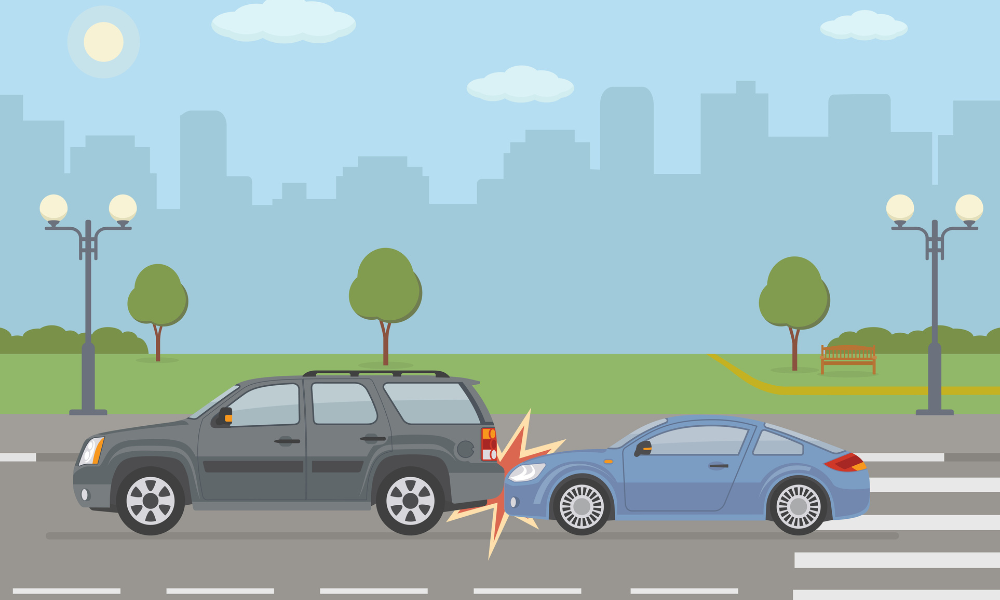Credit: alazur - stock.adobe.com
According to the Canada National Collision Database*, there are a total 17,628 rear-end collisions in 2021 alone; this is around 21% of the 83,590 total collisions of the same year. With this high probability of being involved in one, it’s important to know when a rear-end collision is not your fault. This piece of information is not just to help with your insurance claims or court actions, but also for your overall safety.
When is a rear-end collision not your fault?
The law has established some rules in determining fault in vehicular accidents, such as rear-end collisions.
As a rule, and as presumed by the law, the car at the back is the one that is usually at fault. It is also assumed that the back car is the one that bumped the one in front.
But as with any rule in law, there are exceptions. By presenting evidence, the driver of the rear car can prove that they’re not the one at fault, or they’re only partly to blame.
All of these will be based on the court’s or the insurance company’s sound judgment based on the facts. Although they can use precedents that have similar circumstances in your case, there’s still that leeway that not all cases are exactly the same.
Here’s a video from a lawyer who briefly explains how fault is determined in a car accident:
Protect yourself from the legal impact of rear-end collisions by hiring the best personal injury lawyers in Canada as ranked by Lexpert.
General rule: rear driver is at fault
In a rear-end collision, the general rule across Canada is that the driver of the rear car is presumed to be at fault. This is because it’s presumed that, if they’re driving with reasonable care, the driver should have braked timely to prevent the accident.
This rule places great responsibility on the driver of the second car, who is viewed to be in a better position to stop the accident. However, it also gives the rear driver the chance to dispute this presumption through pieces of evidence.
Provincial fault determination rules
Some provinces have their statutes that can help parties in a collision determine who is at fault or liable. One example is Ontario’s Fault Determination Rules (OFDR).
Insurance companies, both private and government-run, also have their own fault determination rules that they follow. In British Columbia for instance, the Insurance Corporation of British Columbia (ICBC) maintains its own set of rules.
Common among these rules is the use of the general rule in deciding who is at fault in a rear-end collision.
Exception: when rear driver is not liable
By way of exception, but subject to the presentation of evidence, a driver of the rear car is considered not at fault in a rear-end collision in the following circumstances:
-
sudden stop: when the front driver suddenly braked, without any reason, which results in them being rear ended; here, the rear vehicle has no ample time to prevent the collision, especially if both vehicles are running at high speed (if allowed by law or justifiable under the circumstance)
-
third vehicle: when a third vehicle is involved, which is the cause of the rear-end collision; examples are when the third vehicle is the reason for the front driver’s sudden brake, or when it bumped the middle car (the one in the middle; previously the rear-end driver) which caused it to bump the car in front of it
Distribution of liability
Under the law on torts, liability will be distributed among the parties if both are partially negligent in the collision. On the other hand, if the driver of rear car proved that they’re not negligent, then the liability will be 100% shifted to the driver of the car in front.
Exception to the exception: when a rear driver is still at fault
These exceptions are not absolute; there are times when these will not apply in some cases. In a sudden stop, the rear-end driver will still be held liable if it’s found that:
- they should have anticipated the sudden or upcoming stop, given the situation (e.g. in an intersection); or
- they did not leave enough space between them and the front car, as required by law; this is also called tailgating
How do you prove that a collision is not your fault?
Proving that a collision is not your fault would be difficult without the help of a personal injury lawyer. If you’re the rear car driver, your pieces of evidence to disprove any liability on your part may include:
- testimonies of eyewitnesses, or even yourself, on how the collision was the other driver’s fault or negligence
- object evidence, such as your dashcam recordings, pictures of scene of the accident, and other video footages
Best practices when handling rear-end collisions
Whether you’re involved in an actual accident or are just preparing yourself for when it happens, you’re probably wondering when a rear-end collision is not your fault. Knowing about these things, along with the help of your personal injury lawyer, can surely help you in these stressful situations.
Here are the best practices that you should keep in mind when you’re involved in a car collision:
- immediately keep yourself away from harm
- if able, check with the other vehicle if they’re safe
- exchange details with the other driver
- note any possible witness for your side of the story
- promptly seek medical attention
In all of these, it’s better to be proactive and prevent any accident before it happens. As a driver of a rear vehicle, remember to keep a reasonable distance to the car in front, maintain your control over your car, and drive at a reasonable and appropriate speed.
After all, being in the right is always rewarded and protected by the law, as in the case of rear-end collisions.
Still confused when a rear-end collision is not your fault? Talk to the Lexpert-ranked best law firms in Canada for personal injury cases.
*Data from the National Collision Database Online may be accessed here.





